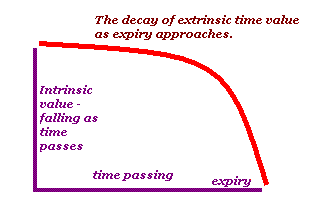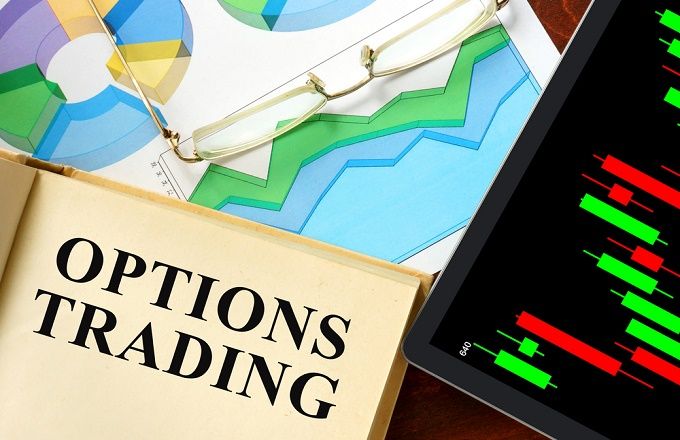Start trading today with our #1 recommended broker, CLICK HERE
Options Value: Now that we understand the basic terminology of equity options and how to read and understand an online option chain, we are now going to look at all the elements which influence the trading value of an option, and how to interpret this information in order to asses the true value, or otherwise, of the option to you as a trader.
Some of the terms may seem very odd, but again you will need to understand them if you are to trade options successfully, and follow all the trading strategies that options can provide to the online trader.
Online Option Trading – Intrinsic & Extrinsic Value
Option buyers and sellers are really only interested in one thing – the price of the option, in other words the premium, so how is this value arrived at, and more importantly what can it tell you about the possibilities for you as a trader. Let’s start with some basic terminology. If we go back to our McDonalds option example, we were looking at the CALL option with a strike price of $55 whilst the actual market price of the stock was $54.56. In this case the option is called an OTM option as it is ‘out of the money’. Had we been looking at the CALL option with a strike price of $57.50, then this would have been called an ITM option – ‘in the money’, and finally had the strike price and the market price been the same, then the option is called ATM or ‘at the money’. Whilst we have applied the above terminology to a CALL option, it is also applied to a PUT option, but remember everything is in reverse!! ( a put option increases in value as the underlying asset falls in value ). A PUT option will be out of the money if the strike price is below the market price, and in the money if the strike price of the option is above the market price
Now whilst the terminology is not that important, the concept of whether an option is in the money, or out of the money is crucial, as every option has two principle components which affect its value as follows :
- Intrinsic value – the CASH value
- Extrinsic value – the TIME value
Online Option Trading – Intrinsic Value
The intrinsic value of any option, is the amount the option is trading in or out of the money. In our example above where the strike price of the call is $55 and the price of the stock in the market is $54.56 then the option has no intrinsic value. So for an OTM option the intrinsic value is ZERO. If we now look at the option chain on the previous page we can see that the call option with a strike price of $52.50 has a premium bid and ask of $2.55 – $2.65. Now the market price of the stock at the moment is $54.56 so the call option has an intrinsic value of ( market price )$54.56-$52.50( strike price ) which is $2.06. This is the intrinsic value of the call option at this particular point. Now clearly this is below the premium being quoted of 2.60 ( taking the mid-point between bid and ask) by approximately 54 cents – so why? Clearly there is another element to the option’s value, and this is the extrinsic value – the TIME element.
Online Option Trading – Extrinsic Value
In the above example of the call option, we were left with 54 cents of ‘value’ in the option price. What does this amount represent? The answer of course is the ‘time’ element of the option as every option has a specific time until expiry. The time element represents to traders the ‘chance’ that an option will finish in the money, and of course, the longer the time available, then the more likelihood there is that this will happen. Let’s take one of my silly examples which I hope will illustrate the point. Suppose you are learning to drive, and have been given 6 months to pass your test – are you likely to succeed – the answer is probably yes as you have plenty of time to take lessons and practice. Suppose you had now been given only 2 weeks – would you pass – it’s possible, but unlikely! So time is against you in the second example, and as we all know, time passes quickly when we have a deadline to meet.
So does this time element change – indeed it does, and not in a linear way either. As expiry approaches the extrinsic value experiences time value decay and becomes the biggest enemy of the option holder. Time is against them decaying faster and faster, until on the day of expiry this element of the option’s value is zero as there is no time left. Above is a graphical representation of how time behaves as the option approaches the expiry date. As you can clearly see, as expiry approaches the extrinsic time value starts to erode very quickly until it has no value at expiry. Now as a option holder, time is always working against you if you are hoping that an option will finish in the money by expiry. Many, many traders will buy an out of the money option, because it is cheap, thinking they have a chance of it moving into the money. The reason it is cheap is because it has no chance whatsoever of becoming a profitable trade, and time works against the trader as the closer expiry comes the less chance there is and the faster time decay works as shown above! The entire premium of an ATM or OTM option is time value since its intrinsic value is zero. Conversely an ITM option at expiry is all intrinsic value since the time value is zero.
One of the reasons I like the covered call writing approach to options trading is simply this, that as an options writer, time works for you, not against you. Time is on your side as the less chance there is that the option finishes in the money, the more chance that you will keep your underlying asset and be able to write another call on the stock. More of this later, but for the meantime, please take on board the above lesson – time works for you as an option seller, and against you as an option holder. For option holders time is liability not an asset. As option writers we use time to our advantage!!
Online Option Trading – Valuing An Option
OK, so we’ve looked at the component elements that make up the options price or cost, but what factors actually affect the options value. In total there are seven factors that play a part in influencing the options value and these are as follows :
- The type of option – Call or Put
- The price of the underlying asset
- The strike price of the option
- The expiry date of the option
- Volatility – Historic and Implied
- Risk free interest rate
- Dividends
Now, of the above list, the one that is most intuitive, yet hardest to analyse is Volatility as there are two parts to it, namely historic and implied which we will look at in a moment. But before moving on we have to discuss the issue of ‘fair value’ and ‘market value’. The fair value is the mathematical calculation of what the options value ‘should’ be. You will no doubt have heard of the Black-Scholes Options pricing model which was devised by two mathematicians in the early 1970’s. This is still the most widely used theoretical model for valuing options and you will find comparisons on most option chains of the actual market value with the theoretical or fair value. Now clearly market prices are set by the market forces of buyers and sellers, and as you will see there is invariably a difference between the perceived fair value, and the actual value. The primary reason for this is in the interpretation of implied volatility and historic volatility, as all the other influencing factors shown above are fixed. It is this that we need to look at next, as understanding these two factors will help you assess those options and stocks that represent good trading opportunities, and those that do not!
Start trading today with our #1 recommended broker, CLICK HERE















